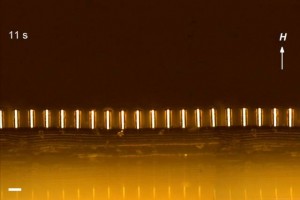A team of engineers from the Massachusetts Institute of Technology (MIT) invented a new elastic material coated with thousands of microscopic, hairlike bristles that can move in response to a magnetic field.

When the field shifts, so do the bristles, and together they can force a fluid into unlikely directions, even against gravity.
Each micro hair, made of nickel, is about 70 microns high and 25 microns wide — about one-fourth the diameter of a human hair. The researchers fabricated an array of the micro hairs onto an elastic, transparent layer of silicone.
In experiments, the magnetically activated material directed not just the flow of fluid, but also light — much as window blinds tilt to filter the sun. Researchers say the work could lead to waterproofing and anti-glare applications, such as “smart windows” for buildings and cars.
“You could coat this on your car windshield to manipulate rain or sunlight,” says Yangying Zhu, a graduate student in MIT’s Department of Mechanical Engineering in a press release.
“So you could filter how much solar radiation you want coming in, and also shed raindrops. This is an opportunity for the future.”
The team of engineers believe that the material also holds the potential to be embedded in lab-on-a-chip devices to magnetically direct the flow of cells and other biological material through a diagnostic chip’s micro channels.
In experiments, the team piped a water solution through a syringe and onto the micro hair array. Under a magnetic field, the liquid only flowed in the direction in which the pillars tilted, while being highly “pinned,” or fixed, in all other directions — an effect that was even seen when the researchers stood the array against a wall. Through a combination of surface tension and tilting pillars, water climbed up the array, following the direction of the pillars.
Since the material’s underlying silicone layer is transparent, the group also explored the array’s effect on light. Zhu shone a laser through the material while tilting the pillars at various angles, and found she could control how much light passed through, based on the angle at which the pillars bent.
According to her, more complex magnetic fields could be designed to create intricate tilting patterns throughout an array. Such patterns may be useful in directing cells through a microchip’s channels, or wicking moisture from a windshield. Since the material is flexible, Wang says that it may even be woven into fabric to create rain-resistant clothing.
“A nice thing about this substrate is that you can attach it to something with interesting contours,” said co-author Evelyn Wang, an associate professor of mechanical engineering.
“Or, depending on how you design the magnetic field, you could get the pillars to close in like a flower. You could do a lot of things with the same platform.”
Click here for video.


















